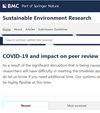泰国电子废物管理的温室气体排放和生命周期成本的生命周期评估
IF 4.8
3区 环境科学与生态学
Q2 ENGINEERING, ENVIRONMENTAL
引用次数: 2
摘要
电气和电子废物的管理没有明确的方向,因为没有关于管理方法的规定。本研究试图了解当前电子废物处理的经济价值和环境影响之间的权衡,以找到优化废物管理的方法,重点关注手机、电视阴极射线管、,台式电脑和空调。对温室气体的生命周期和生命周期成本进行了分析。在电子垃圾管理现状下,大多数家庭电子垃圾都被存放在房子里,因为业主不知道该把它丢弃在哪里。此外,十多年来,非正规部门,如家庭农民或工人,一直积极参与收集和拆除电子垃圾,导致健康和环境管理标准差。在没有电子垃圾管理法规的情况下,非正式的产品拆卸商通过收集和销售零件以及将所有不可回收的垃圾丢弃在城市垃圾场来获得微薄的利润。目前的做法实际上主要是由于物流管理不当和制冷剂丢弃而向大气中添加温室气体。物流效率低下,因为拆解社区和回收地点相距甚远。大多数电子垃圾产生,大多数回收行业位于中部地区(最富裕的地区),而拆解社区位于东北部地区(最贫穷的地区)。此外,温室气体的生命周期和电子垃圾的生命周期成本受到运输的影响,并非所有电子垃圾部件都可以在国内回收。该国无法进行高科技矿产开采,因此,电路板和电池被出口用于回收。为了促进循环经济,应该实施电子废物管理条例,适当的电子废物管理成本应该内化,并且应该在该国建立一个全面的回收行业。本文章由计算机程序翻译,如有差异,请以英文原文为准。
The life-cycle assessment of greenhouse gas emissions and life-cycle costs of e-waste management in Thailand
There is no clear direction in the management of electrical and electronic waste products (e-waste), as there are no regulations on ways to do so. This research attempts to understand the trade-off between the economic value and the environmental effects of the current disposal of e-waste to find ways to optimize waste management, focusing on cellphones, television cathode ray tubes, desktop computers, and air conditioners. A life cycle greenhouse gas and life cycle costs were conducted. Under the e-waste management status quo, most household e-waste is kept in houses because owners do not know where to discard it. In addition, informal sectors, such as domestic farmers or workers, have been actively involved in collecting and dismantling e-waste for more than a decade, leading to poor management standards for both health and the environment. Without e-waste management regulations, informal dismantlers of products gain slight profits by collecting and selling parts and discarding all non-recyclable waste in municipal garbage dumps. The current practice actually adds greenhouse gas to the atmosphere mainly due to improper logistics management and discarding of refrigerants. The logistics are inefficient because the dismantling communities and recycling locations are far apart. Most e-waste is generated, and most recycling industries are located in the central region (the richest areas), while the dismantling communities are located in the northeastern region (the poorest areas). Furthermore, the life cycle of greenhouse gas and the life cycle costs of e-waste are affected by transportation, and not all e-waste parts can be recycled within the country. High-tech mineral extraction cannot be practiced in the country, and thus, circuit boards and batteries are exported for recycling. To promote a circular economy, e-waste management regulations should be implemented, the costs of proper e-waste management should be internalized, and a full recycling industry should be established in the country.
求助全文
通过发布文献求助,成功后即可免费获取论文全文。
去求助
来源期刊

Sustainable Environment Research
Multiple-
CiteScore
8.00
自引率
2.00%
发文量
47
审稿时长
30 weeks
期刊介绍:
The primary goal of Sustainable Environment Research (SER) is to publish high quality research articles associated with sustainable environmental science and technology and to contribute to improving environmental practice. The scope of SER includes issues of environmental science, technology, management and related fields, especially in response to sustainable water, energy and other natural resources. Potential topics include, but are not limited to: 1. Water and Wastewater • Biological processes • Physical and chemical processes • Watershed management • Advanced and innovative treatment 2. Soil and Groundwater Pollution • Contaminant fate and transport processes • Contaminant site investigation technology • Soil and groundwater remediation technology • Risk assessment in contaminant sites 3. Air Pollution and Climate Change • Ambient air quality management • Greenhouse gases control • Gaseous and particulate pollution control • Indoor air quality management and control 4. Waste Management • Waste reduction and minimization • Recourse recovery and conservation • Solid waste treatment technology and disposal 5. Energy and Resources • Sustainable energy • Local, regional and global sustainability • Environmental management system • Life-cycle assessment • Environmental policy instruments
 求助内容:
求助内容: 应助结果提醒方式:
应助结果提醒方式:


